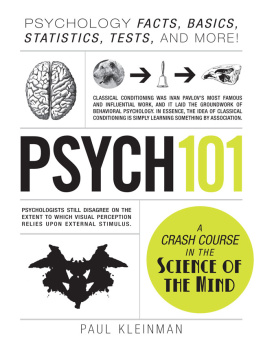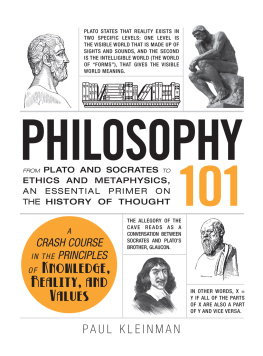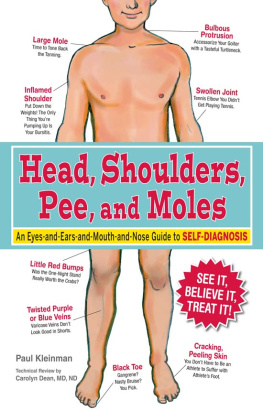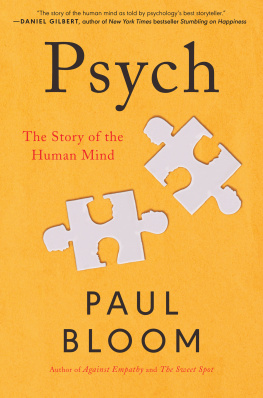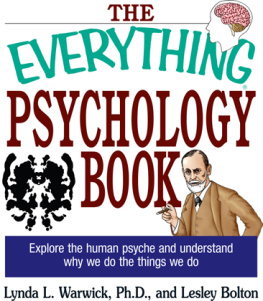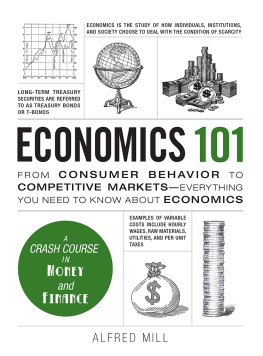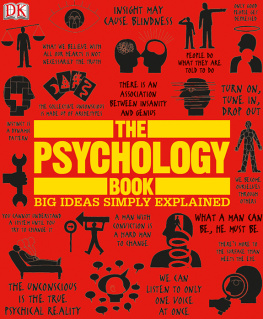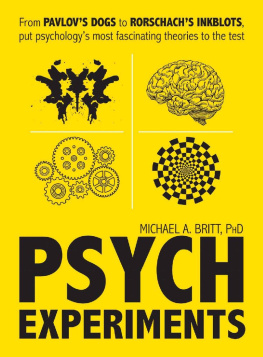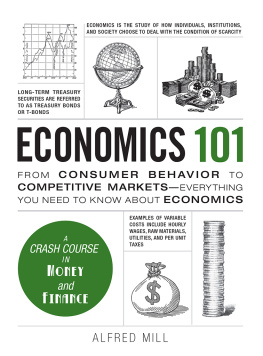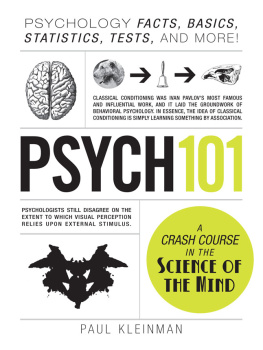Psychology is the study of mental and behavioral processes. Essentially, those who work in the field of psychology try to give meaning to the questions, What makes you tick? and How do you see the world? These very simple ideas encompass many different and complicated topics, including emotions, thought processes, dreams, memories, perception, personality, illness, and treatment.
While the roots of psychology date back to the philosophers of Ancient Greece, it wasnt until 1879, when German psychologist Wilhelm Wundt created the first laboratory completely devoted to the study of psychology, that the field really began to take off. Since then, psychology has expanded exponentially into a truly diverse science, often overlapping with other types of scientific studies such as medicine, genetics, sociology, anthropology, linguistics, biology, and even subjects like sports, history, and love.
So put on your thinking cap, make yourself comfortable (perhaps recline on a couch), and prepare to be enlightened; its time to start learning about yourself in ways you never knew possible. Whether this book is a refresher course or youre learning all of this for the very first time, lets begin. Welcome to Psych 101.
IVAN PAVLOV (18491936)
The man who studied mans best friend
Ivan Pavlov was born in Ryazan, Russia, on September 14th, 1849. The son of the village priest, Pavlov originally studied theology until 1870, when he abandoned his religious studies and attended the University of St. Petersburg to study physiology and chemistry.
From 1884 to 1886, Pavlov studied under renowned cardiovascular physiologist Carl Ludwig and gastrointestinal physiologist Rudolf Heidenhain. By 1890, Pavlov had become a skilled surgeon and took an interest in the regulation of blood pressure. Without the use of any anesthesia, Pavlov was able to almost painlessly insert a catheter into a dogs femoral artery and record the impact that emotional and pharmacological stimuli had on blood pressure. However, Pavlovs most influential research with dogsclassical conditioningwas yet to come.
From 1890 to 1924, Ivan Pavlov worked at the Imperial Medical Academy as a professor of physiology. In his first ten years at the academy, he began to turn his attention towards the correlation between salivation and digestion. Through a surgical procedure, Pavlov was able to study the gastrointestinal secretions of an animal during its life span within relatively normal conditions; and he conducted experiments to show the relationship between autonomic functions and the nervous system. This research led to the development of Pavlovs most important concept, the conditioned reflex. By 1930, Pavlov had begun using his research on conditioned reflexes to explain human psychoses.
Doctoral Definitions
CONDITIONED REFLEX: A response that becomes associated with a previously unrelated stimulus as a result of pairing the stimulus with another stimulus normally yielding the response.
Though he was praised and supported by the Soviet Union, Pavlov was an outspoken critic of the governments Communist regime and even denounced the government publicly in 1923, following a trip to the United States. When, in 1924, the government expelled the sons of priests at the former Imperial Medical Academy (which was then known as the Military Medical Academy in Leningrad), Pavlov, the son of a priest himself, resigned from his position as professor. Dr. Ivan Pavlov died on February 27th, 1936, in Leningrad.
The Many Accolades of Ivan Pavlov
During his lifetime, the research of Dr. Pavlov was met with great praise. Here is a sampling of his achievements:
- Elected as a corresponding member of the Russian Academy of Science (1901)
- Awarded a Nobel Prize for Physiology and Medicine (1904)
- Elected Academician of the Russian Academy of Science (1907)
- Awarded honorary doctorate at Cambridge University (1912)
- Received the Order of the Legion of Honour from the Medical Academy of Paris (1915)
CLASSICAL CONDITIONINGLEARNING BY ASSOCIATION
Classical conditioning was Ivan Pavlovs most famous and influential work, and it laid much of the groundwork of behavioral psychology. In essence, the idea of classical conditioning is simply learning something by association. Pavlov identified four basic principles:
- The Unconditioned Stimulus: A stimulus is any act, influence, or agent that creates a response. An unconditioned stimulus is when the stimulus automatically triggers some type of response. For example, if pollen makes a person sneeze, then pollen is an unconditioned stimulus.
- The Unconditioned Response: This is a response that is automatically triggered as a result of the unconditioned stimulus. In essence, this is a natural, unconscious reaction to whatever the stimulus might be. For example, if pollen makes a person sneeze, the sneeze is the unconditioned response.
- The Conditioned Stimulus: When a neutral stimulus (a stimulus that is not related to the response) becomes associated with an unconditioned stimulus, thus triggering conditioned response.
- The Conditioned Response: This is a response that was learned from the once-neutral stimulus.
Confused? Dont be. Its actually very simple! Imagine if you flinched after hearing a loud sound. The sound triggered a natural response, making it an unconditioned stimulus, and the flinching was the unconditioned response because it was something that you did unconsciously as a result of the unconditioned stimulus.
Now, if you repeatedly witnessed a certain movement happen at the same time as, or a little bit before, the loud noise occurredfor example, a person swinging their fist to slam it on a tableyou might then begin to associate that movement with the loud sound, flinching whenever you see a fist move in a similar manner, even if there is no sound. The movement of the fist (the conditioned stimulus) became associated with the unconditioned stimulus (the sound), and made you flinch (the conditioned response).
PAVLOVS DOGS
Dr. Ivan Pavlov was able to establish these ideas by observing the irregular secretions of nonanesthetized dogs. Pavlov initially began studying digestion in dogs by measuring the amount of saliva that the animals had when both edible and nonedible items were introduced.
Eventually, he began to notice that the dogs would begin salivating every time an assistant entered the room. Believing that the animals were responding to the white coats the assistants wore, Pavlov hypothesized that this production of saliva was actually in response to a certain stimulus, and that these dogs were associating the white coats with the presentation of food. Furthermore, Pavlov noted, the production of saliva that occurred when food was presented to the dogs was an unconditioned reflex, while the production of saliva that was a result of the dogs seeing the white coats was a learned, or conditioned, reflex. To dig deeper into his findings, Pavlov set out to create one of the most famous scientific experiments of all time: Pavlovs dogs.

